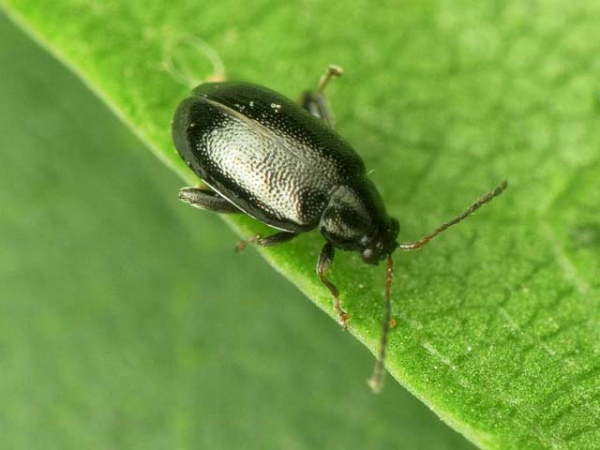How to get rid of a flea on a radish
What is a pest
The cruciferous flea is a pest that is very common in our latitudes. Getting into favorable conditions for themselves, these insects are able to completely destroy the seedlings of not only radish, but also young seedlings of cabbage, radish and other crops of the same family in a few days.
The pest wakes up after wintering, as soon as the soil begins to thaw. In early spring, insects feed on weeds from the cruciferous family, and with the emergence of seedlings of vegetable crops of this family, they are happy to switch to them. That is why it is very important to prevent mass propagation of weeds in the beds, by removing them on time.
Flea larvae, living in the soil, feed on the roots of plants, and crops with root crops infect at the root collar. As the larva develops and rises to the surface, it switches to young leaves, causing them to gradually dry out and leading to the death of the entire plant. Sometimes the flea damages the plant at the point of growth, which naturally kills the plant. The pest is especially active during the dry, hot period.
Prophylaxis
Preventive measures in the fight against such a pest as a cruciferous flea are to process the seedlings in a timely manner. Including folk remedies are widely used. For example, a flea is extremely disliked by naphthalene: you can "powder" the affected young radishes with a mixture of road dust and naphthalene (in a 1: 1 ratio) using a gauze bag. Another effective mixture is tobacco dust, slaked lime and ash, mixed in equal proportions.
Good results can also be achieved by spraying. In this way, you need to process radishes early in the morning, as they say, "in the dew". A product consisting of wood ash (one liter can), water (3 liters) and a few tablespoons of liquid soap can effectively scare away harmful bugs from your garden. But one-time treatment is not enough: the seedlings need to be sprayed with such an infusion every five days, the total number of treatments can reach six.
Another commonly available remedy that is widely used by gardeners to prevent pest damage to radishes is ordinary acetic acid. The recipe for the drug is simple: 1 glass of 9% vinegar is diluted in 10 liters of water. The resulting mixture is sprayed with seedlings. Sometimes, summer residents use an infusion of garlic, a decoction of dandelion leaves or green wormwood as preventive measures. All these decoctions or infusions are very disliked by insect pests.
The geography of planting also helps to prevent the appearance of flea beetles on radishes: potatoes, tomatoes, dill or caraway are planted around crucifers.
All these cultures emit specific substances into the environment that are strongly disliked by bugs and midges. Some flowers have a similar effect, for example, the familiar marigolds or calendula.
Ways to fight
All of the above methods are suitable as preventive measures; they are unlikely to be suitable for dealing with a cleared pest.
The most effective method is to treat plants with an insecticide, for example, Inta-Vir. But this tool can be used with some restrictions:
- the drug is applicable only for medium-sized radishes, whose ripening period is at least 25 days, otherwise the lion's share of the product will settle in root crops;
- processing can be carried out exclusively on young seedlings, until the root crop begins to form, and only if the threat of destruction hangs over all the seedlings.
There is another, rather exotic, way of dealing with such a pest as a flea: radish shoots are covered with a white agrospan.
If the weather is not very hot, then the plants under the shelter do not stretch out, and the flea on them will not start en masse. After the seedlings are sufficiently strong, the covering material should be removed, and further processing of the beds should be done with wood ash.
And finally, here are some useful tips to help you grow your radishes healthy and healthy:
- try to organize drip irrigation of radishes so that the ash infusion is not washed off from the leaves during the first watering from above;
- if weeds from the cruciferous family grow near the radish beds, it will not be superfluous to treat them with special chemistry from pests;
- you should not resort to specialized chemicals for pest control on early varieties of radish: you will most likely get rid of bugs, but you will pretty much “pump” the radishes with harmful substances that will not bring you anything useful.
Video "Fighting the cruciferous flea"
In this video, you will find helpful tips on how to deal with a flea on cruciferous plants.




